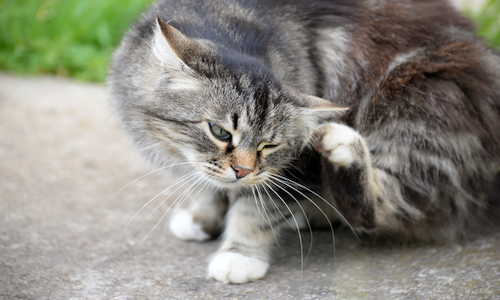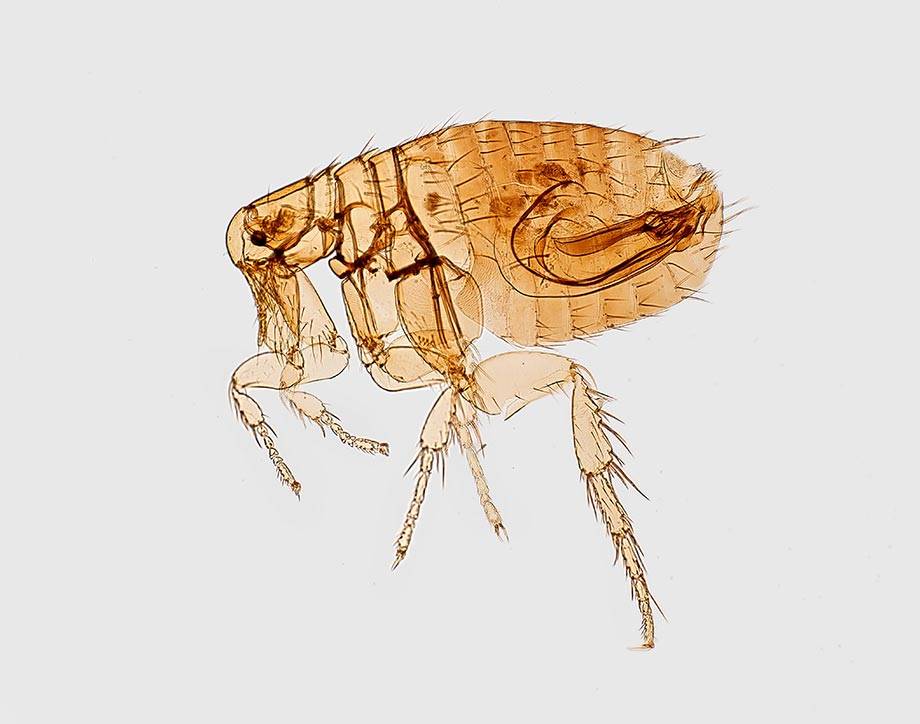Fleas are tiny little insects, roughly around 3mm in length, with long back legs designed for jumping long distances. They don’t have wings, but they can travel quite far just by jumping. Fleas are typically reddish-brown or brown in color with thin, flat, hairy-looking bodies (that get fatter as they gorge themselves) and mouthparts like tiny siphons. These tiny siphons are designed to help them stab and suck the blood of their host.
Fleas have six legs and are more than able to jump large distances as they move from host to host. Their color helps them blend into the fur or hair of their host, while their thin, flat shape helps them move easily through thick fur. They have a hard exoskeleton and the “hair” on their bodies points backward. By design, this feature is meant to better help anchor them to their host.
Fleas may or may not have eyes, as they usually navigate their host based on their sense of smell and their antennae. Though adult fleas are small, they can be seen with the naked eye and are often found moving through an animal’s fur as they feast.
There are over 2,000 species of fleas worldwide, with 300 species residing in North America, there are only two species that seem to be most common in cats and dogs. One is the cat flea, or ctenocephalides felis, and the other is the dog flea, or ctenocephalides canis. There are also rat fleas, human fleas, raccoon fleas, rabbit fleas, and more.
Although all species have a specific host they prefer, it doesn’t stop them from feeding on other types of hosts. This means that the cat flea can affect dogs and the dog flea can affect cats and either type of flea has no problem feeding on humans or other animals, either. Dog and cat fleas both carry the parasite that creates tapeworms, and the oriental rat flea is a carrier of the bubonic plague.
Other Flea Species

Even though the most common types of fleas found in North America are the domestic cat and dog flea species, there are others to be found. In addition to the oriental rat flea (scientifically known as the xenopsylla cheopsis) that prefers feeding off rats, there is also a rabbit flea (or spilopsyllus cuniculi) found on both wild and pet rabbits, and the sticktight flea.
The sticktight flea is also called the tropical hen flea (or echidnophaga gallinacea) and feeds mainly off of poultry. There is even species of fleas that loves feeding on humans. One is called the human flea (or pulex irritans) and the other is called the false human flea (or pulex simulans). Both love humans as their host, but in a pinch are happy to feast on dogs, cats, and pigs too.
Because these two flea species are so closely related, you will often find the human flea and the false human flea in close proximity to each other. Both of these flea types can be found on dogs and cats, as well as wild canines quite regularly.
In North America, when someone has a flea infestation in their home with one of their pets, the most likely culprit is the domestic cat flea. In Europe, the dog flea is most often the culprit. However, someone can develop a flea infestation of any species of flea, no matter where they are. It’s just not as common as the cat and dog flea species.
The Life Cycle of a Flea
The life of a flea progresses through four stages:






